The brainstem pathologies of Parkinson's disease and dementia with Lewy bodies
- PMID: 24995389
- PMCID: PMC4397912
- DOI: 10.1111/bpa.12168
The brainstem pathologies of Parkinson's disease and dementia with Lewy bodies
Abstract
Parkinson's disease (PD) and dementia with Lewy bodies (DLB) are among the human synucleinopathies, which show alpha-synuclein immunoreactive neuronal and/or glial aggregations and progressive neuronal loss in selected brain regions (eg, substantia nigra, ventral tegmental area, pedunculopontine nucleus). Despite several studies about brainstem pathologies in PD and DLB, there is currently no detailed information available regarding the presence of alpha-synuclein immunoreactive inclusions (i) in the cranial nerve, precerebellar, vestibular and oculomotor brainstem nuclei and (ii) in brainstem fiber tracts and oligodendroctyes. Therefore, we analyzed the inclusion pathologies in the brainstem nuclei (Lewy bodies, LB; Lewy neurites, LN; coiled bodies, CB) and fiber tracts (LN, CB) of PD and DLB patients. As reported in previous studies, LB and LN were most prevalent in the substantia nigra, ventral tegmental area, pedunculopontine and raphe nuclei, periaqueductal gray, locus coeruleus, parabrachial nuclei, reticular formation, prepositus hypoglossal, dorsal motor vagal and solitary nuclei. Additionally we were able to demonstrate LB and LN in all cranial nerve nuclei, premotor oculomotor, precerebellar and vestibular brainstem nuclei, as well as LN in all brainstem fiber tracts. CB were present in nearly all brainstem nuclei and brainstem fiber tracts containing LB and/or LN. These findings can contribute to a large variety of less well-explained PD and DLB symptoms (eg, gait and postural instability, impaired balance and postural reflexes, falls, ingestive and oculomotor dysfunctions) and point to the occurrence of disturbances of intra-axonal transport processes and transneuronal spread of the underlying pathological processes of PD and DLB along anatomical pathways.
Keywords: Parkinson's disease; alpha-synuclein; brainstem; dementia with Lewy bodies; prion-like disease.
© 2014 International Society of Neuropathology.
Figures
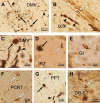
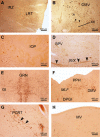
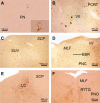
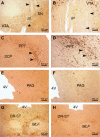
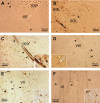
References
-
- Ahmed Z, Asi YT, Sailer A, Lees AJ, Houlden H, Revesz T, Holton JL (2012) The neuropathology, pathophysiology and genetics of multiple system atrophy. Neuropathol Appl Neurobiol 38:4–24. - PubMed
-
- Angot E, Steiner JA, Hansen C, Li JY, Brundin P (2010) Are synucleinopathies prion‐like disorders? Lancet Neurol 9:1128–1138. - PubMed
-
- Barmack NH (2003) Central vestibular system: vestibular nuclei and posterior cerebellum. Brain Res Bull 60:511–541. - PubMed
-
- Benarroch EE (2013) Pedunculopontine nucleus: functional organization and clinical implications. Neurology 80:1148–1155. - PubMed
-
- Benarroch EE, Schmeichel AM, Sandroni P, Low PA, Parisi JE (2006) Involvement of vagal autonomic nuclei in multiple system atrophy and Lewy body disease. Neurology 66:378–383. - PubMed
Publication types
MeSH terms
Substances
Grants and funding
LinkOut - more resources
Full Text Sources
Other Literature Sources
Medical
Research Materials

